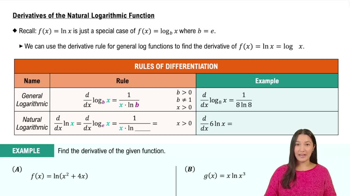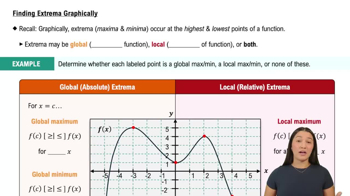Table of contents
- 0. Functions7h 52m
- Introduction to Functions16m
- Piecewise Functions10m
- Properties of Functions9m
- Common Functions1h 8m
- Transformations5m
- Combining Functions27m
- Exponent rules32m
- Exponential Functions28m
- Logarithmic Functions24m
- Properties of Logarithms34m
- Exponential & Logarithmic Equations35m
- Introduction to Trigonometric Functions38m
- Graphs of Trigonometric Functions44m
- Trigonometric Identities47m
- Inverse Trigonometric Functions48m
- 1. Limits and Continuity2h 2m
- 2. Intro to Derivatives1h 33m
- 3. Techniques of Differentiation3h 18m
- 4. Applications of Derivatives2h 38m
- 5. Graphical Applications of Derivatives6h 2m
- 6. Derivatives of Inverse, Exponential, & Logarithmic Functions2h 37m
- 7. Antiderivatives & Indefinite Integrals1h 26m
- 8. Definite Integrals4h 44m
- 9. Graphical Applications of Integrals2h 27m
- 10. Physics Applications of Integrals 2h 22m
5. Graphical Applications of Derivatives
Intro to Extrema
Problem 4.1.35
Textbook Question
Locating critical points Find the critical points of the following functions. Assume a is a nonzero constant.
ƒ(x) = 1 / x + ln x
 Verified step by step guidance
Verified step by step guidance1
To find the critical points of the function \( f(x) = \frac{1}{x} + \ln x \), we first need to find its derivative \( f'(x) \).
Differentiate \( f(x) \) with respect to \( x \). The derivative of \( \frac{1}{x} \) is \( -\frac{1}{x^2} \) and the derivative of \( \ln x \) is \( \frac{1}{x} \). Therefore, \( f'(x) = -\frac{1}{x^2} + \frac{1}{x} \).
Set the derivative \( f'(x) \) equal to zero to find the critical points: \( -\frac{1}{x^2} + \frac{1}{x} = 0 \).
Solve the equation \( -\frac{1}{x^2} + \frac{1}{x} = 0 \) for \( x \). This involves finding a common denominator and simplifying the equation.
After solving the equation, determine the values of \( x \) that satisfy it. These values are the critical points of the function \( f(x) \).
 Verified video answer for a similar problem:
Verified video answer for a similar problem:This video solution was recommended by our tutors as helpful for the problem above
Video duration:
3mPlay a video:
Was this helpful?
Key Concepts
Here are the essential concepts you must grasp in order to answer the question correctly.
Critical Points
Critical points of a function occur where its derivative is either zero or undefined. These points are essential for identifying local maxima, minima, and points of inflection. To find critical points, one must first compute the derivative of the function and then solve for the values of x that satisfy the condition of the derivative being zero or undefined.
Recommended video:

Critical Points
Derivative
The derivative of a function measures the rate at which the function's value changes as its input changes. It is a fundamental concept in calculus that provides information about the function's slope at any given point. For the function ƒ(x) = 1/x + ln x, the derivative must be calculated to locate the critical points, which involves applying the rules of differentiation.
Recommended video:

Derivatives
Natural Logarithm
The natural logarithm, denoted as ln(x), is the logarithm to the base e, where e is approximately 2.71828. It is a key function in calculus, particularly in integration and differentiation. In the context of the given function, understanding the properties of the natural logarithm is crucial for correctly differentiating and analyzing the function's behavior near its critical points.
Recommended video:

Derivative of the Natural Logarithmic Function

 5:58m
5:58mWatch next
Master Finding Extrema Graphically with a bite sized video explanation from Callie
Start learning





